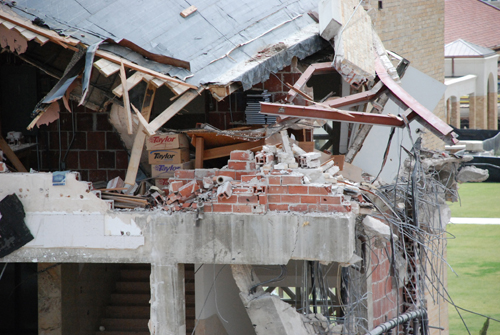
What we left behind
The yearbook advisor discovered a hidden treasure amid the rubble of the Brown-Lupton Student Center. With four TCU offspring, she found that memories - and a lot more - will stand the test of time.

By Kathy Cribari Hamer
Publications Coordinator for Student Affairs
Everybody leaves things behind sometimes. Once I forgot my daughter Abby. But she was small at the time, and that was the year she had taken a vow of silence, so it was understandable.
At least I should get credit for having left her behind at St. Andrew's. If you have to accidentally forget a 4-year-old, why not at the parochial school? They have an unwritten code of "in loco parentis," don't they? And they never release a child without a claim check, right?
Oh sure, Abby hadn't started school yet, so there was no claim check at all, but the family resemblance told who she belonged to: the person who had ignorantly, clumsily driven away from the parish with three instead of four of her kids.
If Abby had not been so quiet that year, it never would have happened.
Fortunately the vice principal knew where we lived, and she approached my driveway, right on my tail. It was a happy ending. Abby, one of my five treasures, was back in the chest.
I told my daughter Meredith my thoughts about leaving things behind for those who come after us. "I know what you mean," she said. "Our neighbors left a cutout cardboard lady sitting at a spinning wheel in the attic. It was creepy. People could look in the window and they thought the lady lived there! But she was paper.
"She's gone now," Meredith said. "I miss her."
While we live, we have endless opportunities to leave behind our mark, something that says, "I was here. This is what I left for you."
Right now it is important to most of us that we leave the Earth as it was when we got it, and not scorched, dried up or mostly dead. As keepers of the world, we hope to leave behind a presence of something, like clean air. Fine art. Splendid music.
But we also should leave behind an absence of something, like the remains of war.
Last month, the landmark Brown-Lupton Student Center was demolished in order to make room for new construction. It was a sad process that actually took more than a month, as we all looked on with fascination.
A few days before the building was completely down, I ventured to the third floor of Reed Hall, the building behind the student center, opened a window and photographed the scene below. Cranes and bulldozers had devastated the loved place where young people met and later married, where children attended dance and band camps, where advance-placement teachers convened for workshops, and where TCU life was centered. Most of my children had been there. Abby filmed every activity for three years. Julie cheered. Meredith danced. Andrew joked.
All that was left now were concrete slabs, with mangled, deranged pipes bent out of what once were walls. There were broken bricks, interrupted stairways and crumbling marble columns. All that remained of the building was the front facade - and that was a heartbeat from extinction.
As I photographed the ongoing effort, I realized I was directly across from the third floor office I had occupied for more than eight years. "Wait," I thought, "There must be something in there of mine - of the yearbook program."
So, I zoomed my camera's lens as close as I would ever get, again, to that space.
And there, under a sloping piece of metal that once was my ceiling, were four boxes. Each of them, in bright red letters said, "Taylor Yearbook Publishing." Behind them, along the building's front wall - was a stack of some 15 books. All alone. Stacked as I had left them for the recycling bin.
Our tiny offices were destroyed. But the yearbook boxes remained intact, as if to say "I will live on." I smiled at them.
The yearbooks were a symbol of the years that preceded this one, and all the people in them and about them, and the building in which the books were created.
For me, they were a symbol of the lives we touched.
They were the last things standing in the Brown-Lupton Student Center. They were history within history.
They were what we left behind.
Contact Hamer at k.hamer@tcu.edu.

Comment at tcumagazine@tcu.edu
|



